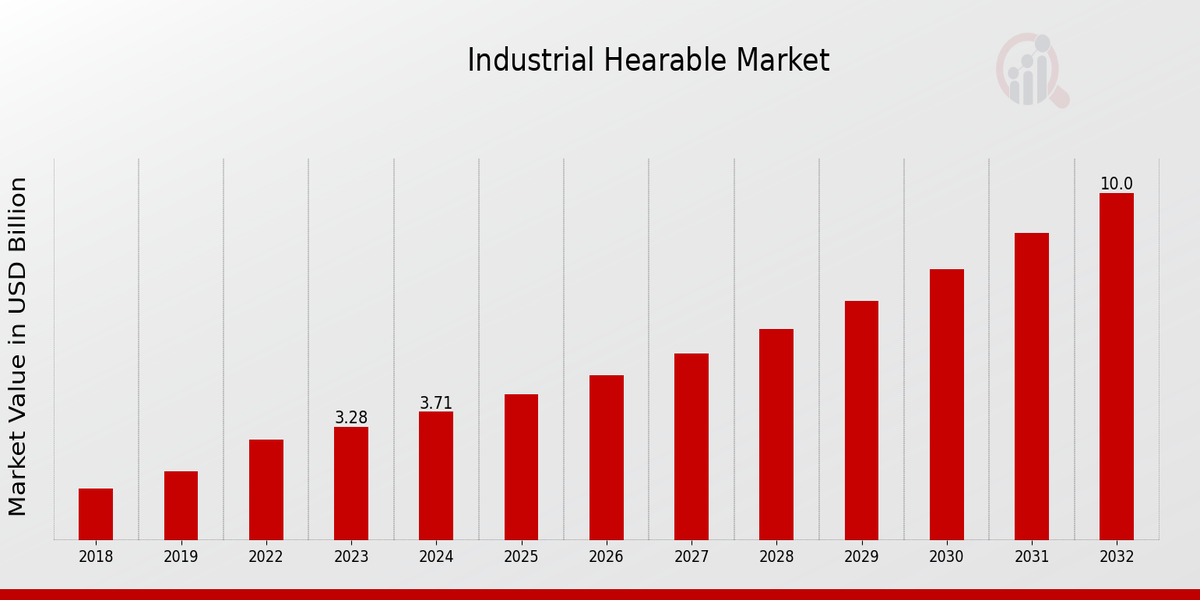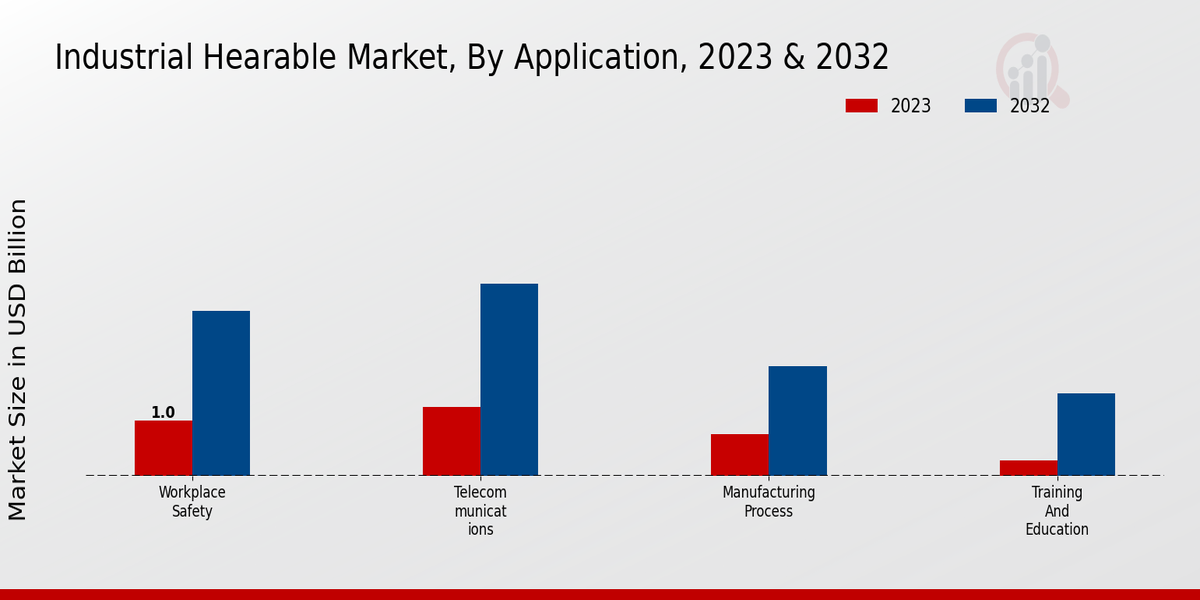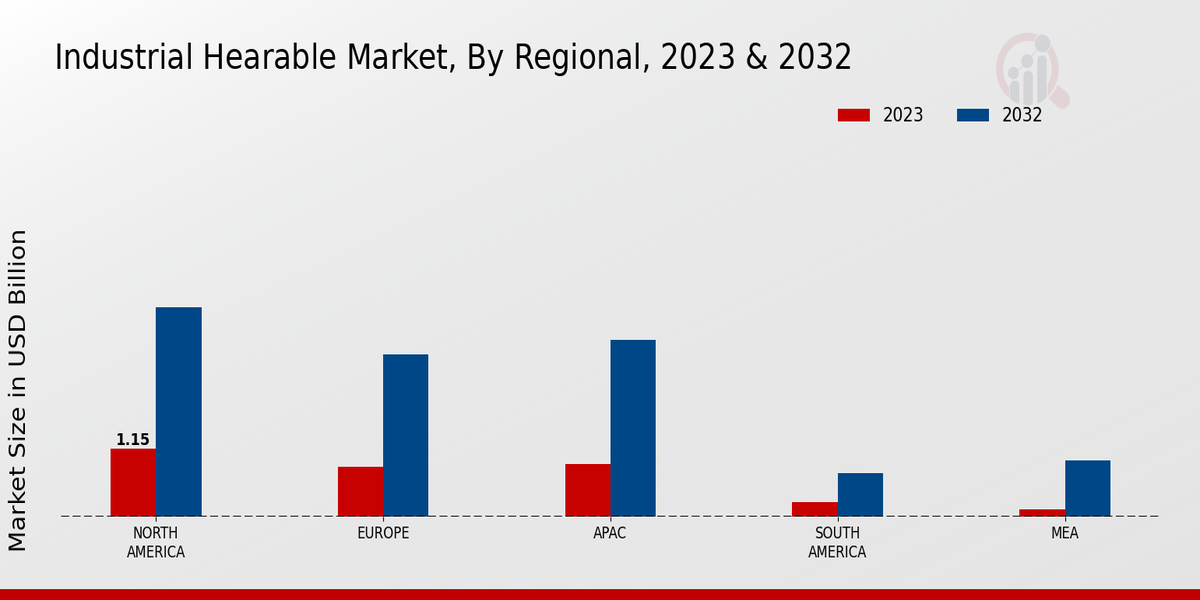Global Industrial Hearable Market Overview:
Industrial Hearable Market Size was estimated at 2.9 (USD Billion) in 2022. The Industrial Hearable Market Industry is expected to grow from 3.28(USD Billion) in 2023 to 10.0 (USD Billion) by 2032. The Industrial Hearable Market CAGR (growth rate) is expected to be around 13.18% during the forecast period (2024 - 2032).
Key Industrial Hearable Market Trends Highlighted
The Industrial Hearable Market is currently experiencing significant growth driven by advancements in audio technology, increasing demand for hands-free communication, and the growing awareness of workplace safety. Companies are investing in wireless hearables to enhance employee productivity and ensure seamless connectivity in various industrial environments. This push for enhanced communication solutions is accelerating the adoption of hearable devices, as they provide convenience and integrate well with existing industrial applications. Additionally, the growing trend of remote work and the need for better virtual collaboration tools are contributing factors.
In recent times, opportunities such as the integration of artificial intelligence and machine learning into hearable devices are becoming more prominent. These technologies can enhance personalization and functionality, allowing for improved user experiences and the automation of tasks through voice commands. Additionally, the rise of IoT (Internet of Things) in industrial settings provides a fertile ground for hearables to become an integral part of smart workplaces, allowing for better interactions between machines and employees. Innovations in battery life and miniaturization also create new possibilities for diverse applications of hearables in industries ranging from manufacturing to logistics.
As the market evolves, trends such as customization and the demand for specialized features that cater to specific industrial needs are shaping product offerings. Companies that focus on ergonomic designs and adaptability to various industrial environments are likely to gain competitive advantages. Moreover, the increasing emphasis on worker health and wellness will drive further development in noise-cancellation features and communication clarity in hearable devices. Overall, the future of the Industrial Hearable Market looks bright, with various forces driving innovation and new technologies creating exciting pathways for growth.

Source: Primary Research, Secondary Research, MRFR Database and Analyst Review
Industrial Hearable Market Drivers
Technological Advancements in Audio Devices
The Industrial Hearable Market Industry is experiencing significant growth driven by rapid advancements in audio technology. Innovations in sound quality, noise cancellation, and wireless connectivity are altering the landscape of hearable devices. Companies are constantly striving to enhance user experience by incorporating features that allow users to interact with their environments seamlessly. This includes integrating artificial intelligence and machine learning for personalized audio adjustments based on user preferences or ambient noise levels.
Furthermore, the push towards smart hearable devices, which are capable of pairing with a range of industrial applications and devices, is increasing the adoption of hearables across various sectors, such as manufacturing, logistics, and healthcare. As organizations look for ways to boost productivity and ensure efficient communication in noisy work environments, hearable technology that provides hands-free communication solutions becomes increasingly essential.The combination of enhanced audio performance with smart features positions these devices as pivotal tools in industrial settings, ultimately fueling the growth of the market.
Additionally, the growing trend of remote work and digital transformation is encouraging further investment in hearable technologies as companies seek innovative ways to maintain communication and enhance employee efficiency from various locations. Overall, the continuous evolution of audio technology and its integration into industrial applications remains a cornerstone for the expansion of the Industrial Hearable Market Industry.
Rising Demand for Wireless Connectivity
The increasing demand for wireless connectivity is a major driver for the Industrial Hearable Market Industry. As businesses prioritize flexible and mobile work environments, the reliance on wireless hearable devices has surged. These devices enable workers to communicate effectively without the constraints of wires, enhancing productivity and safety in various industrial settings. The shift towards wireless technology also caters to the growing trend of remote working, allowing employees to stay connected even when they are on the move.
Emphasis on Health and Safety Regulations
The heightened emphasis on health and safety regulations within industrial environments is significantly contributing to the growth of the Industrial Hearable Market Industry. Companies are increasingly recognizing the importance of protecting their workforce from noise-induced hearing loss and other auditory hazards. Consequently, the adoption of hearable technology that not only facilitates communication but also provides hearing protection is becoming essential.This trend ensures that organizations comply with safety standards while boosting employee well-being.
Industrial Hearable Market Segment Insights:
Industrial Hearable Market Application Insights
The Industrial Hearable Market is experiencing robust growth, particularly in its Application segment, which comprises Workplace Safety, Telecommunications, Manufacturing Process, Training and Education. As of 2023, the overall market is valued at 3.28 USD Billion and is expected to reach 10.0 USD Billion by 2032, reflecting significant progress driven by tech advancements and increasing workplace efficiency demands. Workplace Safety influences this segment with a valuation of 1.0 USD Billion in 2023 and projected growth to 3.0 USD Billion in 2032, showcasing the importance of auditory technologies in ensuring employee safety and compliance in various workplaces.
Telecommunications dominated with a, valuation of1.25 USD Billion in 2023 and anticipated to rise to 3.5 USD Billion by 2032. This growth is attributed to the rising need for efficient communication tools that enhance operational effectiveness and connectivity among employees. Manufacturing Process accounts for 0.75 USD Billion in 2023, expected to increase to 2.0 USD Billion by 2032. This highlight indicates the relevance of hearable technology in streamlining operations and enhancing productivity on factory floors. Finally, the Training and Education segment, while smaller, valued at 0.28 USD Billion in 2023 and projected to reach 1.5 USD Billion by 2032, plays a significant role by integrating hearables in educational tools, improving learning experiences, and facilitating access to information.
The Industrial Hearable Market segmentation highlights the diverse applications of hearable technology, reflecting the industry's growth drivers, including technological advancements, rising safety awareness, and the need for effective communication and training methods across various sectors.

Source: Primary Research, Secondary Research, MRFR Database and Analyst Review
Industrial Hearable Market End Use Insights
The Industrial Hearable Market is expected to play a crucial role across various end-use categories, significantly shaping its overall dynamics. By 2023, the market reached a valuation of 3.28 billion USD, highlighting the growing importance of hearable technology in enhancing operational efficiency and safety. Within this segment, categories like Healthcare, Construction, Manufacturing, and Logistics are vital, with Healthcare witnessing substantial demand due to the increasing need for improved patient monitoring and communication solutions.
Construction and Manufacturing are crucial as they often require real-time communication among workers in challenging environments, making hearables indispensable for operational efficiency and safety compliance. Logistics benefits significantly from these devices, streamlining processes and improving coordination in large warehouses and shipping facilities. Collectively, these sectors emphasize the critical role of Industrial Hearable Market revenue generation and diversification. As this industry evolves, trends such as increased adoption of AI and machine learning in hearable devices present lucrative opportunities, although challenges like data privacy and integration with existing systems persist, highlighting the need for innovation in the Industrial Hearable Market statistics.
Industrial Hearable Market Technology Insights
The Industrial Hearable Market is witnessing significant growth within the Technology segment, which is projected to reach a valuation of USD 3.28 Billion in 2023 and expand considerably in the following years. This market demonstrates a robust growth trajectory, expected to provide ample opportunity through innovations within various technologies. Bone conduction technology is gaining traction due to its unique ability to transmit sound through the bones of the skull, allowing for safer and more comfortable listening experiences, especially in industrial environments.
Meanwhile, the Active Noise Cancellation technology is rapidly becoming essential as it enhances focus and productivity by minimizing ambient noise, proving invaluable in noisy workspaces. Additionally, Augmented Hearing technology is also making strides as it assists users in discerning sounds in complex environments, complementing safety and communication needs. The interplay of these technologies drives the Industrial Hearable Market segmentation, making it a dynamic and competitive industry with diverse applications aimed at meeting the evolving demands of various sectors.
Industrial Hearable Market Form Factor Insights
The Industrial Hearable Market, valued at 3.28 USD Billion in 2023, showcases diverse form factors that cater to various consumer needs. The segmentation includes In-Ear, Over-Ear, and On-Ear designs, each offering unique benefits. In-Ear devices often excel in portability and convenience, making them highly favored in industrial settings where mobility is essential. Over-Ear models typically provide better sound isolation and comfort for extended use, making them significant for tasks requiring prolonged listening.
On-Ear designs strike a balance between comfort and compactness, appealing to users who need a blend of both. This variety not only addresses user preferences but also aligns with advancements in technology, enhancing audio quality and connectivity options. Moreover, the market trends show an increasing demand for hearables in industrial applications driven by the need for effective communication and hands-free operations in noisy environments. The Industrial Hearable Market data illustrates how manufacturers are focusing on innovation and customization, positioning themselves to capitalize on the growing awareness and adoption of hearable technology across various industries. As this segment evolves, it presents both opportunities and challenges, with competition intensifying among key players aiming to establish dominance in the market.
Industrial Hearable Market Regional Insights
The Industrial Hearable Market is expanding significantly, with a noted valuation of 3.28 USD Billion in 2023, projected to reach 10.0 USD Billion by 2032. Within the regional segmentation, North America holds a significant position, showcasing a market value of 1.15 USD Billion in 2023, which is expected to rise to 3.55 USD Billion by 2032, thus dominating the overall market. Europe follows closely with a value of 0.85 USD Billion in 2023, anticipated to grow to 2.75 USD Billion by 2032, driven by technological advancements and rising consumer demand.
The APAC region, reflecting a valuation of 0.9 USD Billion in 2023, is also on a robust growth trajectory, with expectations of reaching 3.0 USD Billion by 2032, indicating a rising trend towards automation and connectivity in industries. South America is estimated at 0.25 USD Billion in 2023 and aims for 0.75 USD Billion by 2032, marking it as an emerging market with increasing industrial applications. Lastly, the MEA region, currently valued at 0.13 USD Billion in 2023, has projections of 0.95 USD Billion by 2032, highlighting the growing recognition of industrial hearables in diverse sectors. Each region plays a crucial role in the expansion of the Industrial Hearable Market revenue, with North America and Europe together accounting for the majority holding due to their advanced infrastructure and innovation-driven environments.

Source: Primary Research, Secondary Research, MRFR Database and Analyst Review
Industrial Hearable Market Key Players and Competitive Insights:
The Industrial Hearable Market has witnessed rapid growth driven by advancements in technology, increasing demand for wireless communication, and the pursuit of enhanced audio experiences in industrial settings. As industries seek efficient ways to communicate in noisy environments, hearable devices have emerged as essential tools for improving productivity and safety. Competitive insights reveal that several players are vying for market share, focusing on innovative product offerings, strategic partnerships, and expanding their reach in various industrial sectors. Key trends observed include the integration of smart features such as noise cancellation, voice recognition, and health monitoring, which are transforming how hearables are utilized in the workplace.
Shure has established a prominent presence in the Industrial Hearable Market, recognized for its high-quality audio solutions tailored for professional environments. The company's extensive experience in audio technology allows it to deliver products that excel in sound clarity and reliability. Shure's strengths lie in its innovative designs and superior acoustic performance, often appealing to industries requiring precise audio feedback and communication. Additionally, the company’s commitment to durability and user comfort makes its hearable devices suitable for long-term use in demanding industrial conditions. Shure also benefits from a robust distribution network, ensuring that their products reach a wide array of sectors, including manufacturing, construction, and transportation, where effective communication is paramount. Plantronics is another key player in the Industrial Hearable Market, renowned for its advanced communication solutions that enhance collaborative efforts across various industries.
With a clear focus on wireless technologies, Plantronics has developed hearable devices that not only ensure seamless connectivity but also prioritize user experience through ergonomic designs and intuitive features. The company’s strengths lie in its ability to integrate smart technologies such as real-time translation and voice-activated controls, which cater to a diverse workforce and improve operational efficiency. Plantronics has also positioned itself strategically in the market by partnering with key industry players, expanding its reach and optimizing its product offering based on customer feedback. This adaptability allows Plantronics to remain competitive by meeting the evolving needs of the industrial sector while maintaining high standards of performance and reliability in its hearable devices.
Key Companies in the Industrial Hearable Market Include:
-
Shure
-
Plantronics
-
Bose
-
Samsung
-
Apple
-
Microsoft
-
Amazon
-
AudioTechnica
-
Harman
-
Sony
-
Sennheiser
-
LG Electronics
-
Panasonic
-
Jabra
-
Google
Industrial Hearable Market Industry Developments
Recent developments in the Industrial Hearable Market have observed a surge in demand for advanced audio solutions, driven by the increasing integration of AI and IoT technologies. Companies like Apple and Samsung continue to innovate, introducing features such as noise cancellation and voice assistants in their hearable devices. Shure and Sennheiser are gaining traction in the professional audio segment, focusing on delivering high-fidelity sound for industrial applications. Significant market growth is noted, with these brands expanding their portfolios to include cutting-edge wireless solutions aimed at enhancing user experience.
In terms of mergers and acquisitions, notable activity includes Bose exploring partnerships to expand its reach in personalized audio technology, while Sony has bolstered its market position through the acquisition of smaller firms specializing in wearable audio devices. Moreover, Microsoft has focused on cloud-based audio solutions for enterprise applications, reflecting a trend towards integrating hearable technology into larger ecosystems. With the competition heating up, companies like Jabra and Harman also continue to innovate, contributing to a dynamic landscape that emphasizes connectivity, functionality, and quality in hearables. This rapid evolution is indicative of a robust and growing industrial hearable market.
Industrial Hearable Market Segmentation Insights
Industrial Hearable Market Application Outlook
- Workplace Safety
- Telecommunications
- Manufacturing Process
- Training and Education
Industrial Hearable Market End Use Outlook
- Healthcare
- Construction
- Manufacturing
- Logistics
Industrial Hearable Market Technology Outlook
- Bone Conduction
- Active Noise Cancellation
- Augmented Hearing
Industrial Hearable Market Form Factor Outlook
Industrial Hearable Market Regional Outlook
- North America
- Europe
- South America
- Asia Pacific
- Middle East and Africa
| Report Attribute/Metric |
Details |
| Market Size 2022 |
2.9 (USD Billion) |
| Market Size 2023 |
3.28 (USD Billion) |
| Market Size 2032 |
10.0 (USD Billion) |
| Compound Annual Growth Rate (CAGR) |
13.18% (2024 - 2032) |
| Report Coverage |
Revenue Forecast, Competitive Landscape, Growth Factors, and Trends |
| Base Year |
2023 |
| Market Forecast Period |
2024 - 2032 |
| Historical Data |
2019 - 2023 |
| Market Forecast Units |
USD Billion |
| Key Companies Profiled |
Shure, Plantronics, Bose, Samsung, Apple, Microsoft, Amazon, AudioTechnica, Harman, Sony, Sennheiser, LG Electronics, Panasonic, Jabra, Google |
| Segments Covered |
Application, End Use, Technology, Form Factor, Regional |
| Key Market Opportunities |
Growing demand for ergonomic designs, Integration of AI for analytics, Rise in remote workforce connectivity, Expansion in factory automation solutions, Focus on health monitoring functionalities |
| Key Market Dynamics |
Increasing demand for wearables, Advances in audio technology, Growing industrial automation, Rising focus on employee safety, Enhanced connectivity features |
| Countries Covered |
North America, Europe, APAC, South America, MEA |
Frequently Asked Questions (FAQ) :
The Industrial Hearable Market is expected to be valued at 10.0 USD Billion by 2032.
The expected CAGR for the Industrial Hearable Market from 2024 to 2032 is 13.18%.
In 2032, the Workplace Safety application segment is projected to grow to 3.0 USD Billion, having the largest market share.
The North American market for Industrial Hearables is expected to reach 3.55 USD Billion by 2032.
The Telecommunications segment is expected to be valued at 3.5 USD Billion by 2032.
The Manufacturing Process segment is anticipated to be valued at 2.0 USD Billion by 2032.
Major players in the market include Shure, Plantronics, Bose, and Samsung among others.
The APAC region is expected to reach a market size of 3.0 USD Billion by 2032.
The Training and Education application segment is expected to be worth 1.5 USD Billion by 2032.
The South American Industrial Hearable Market is anticipated to be valued at 0.75 USD Billion by 2032.





























